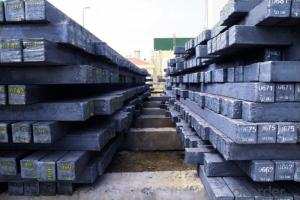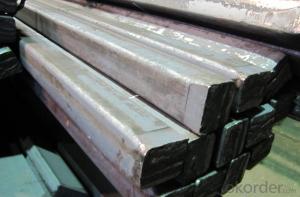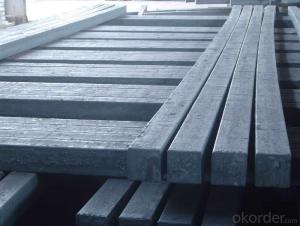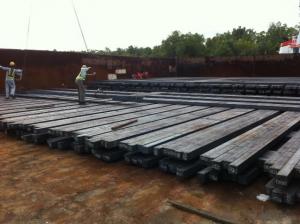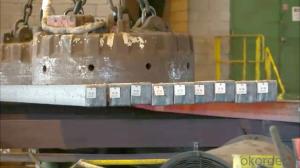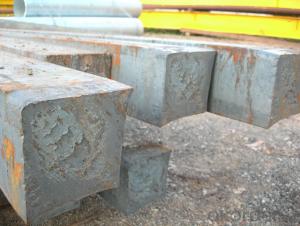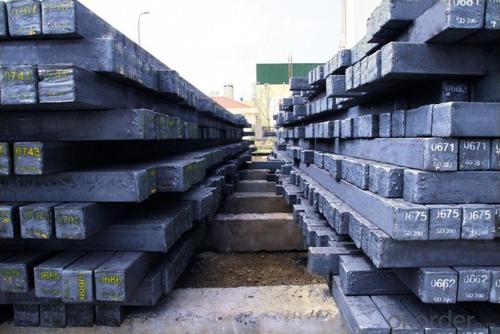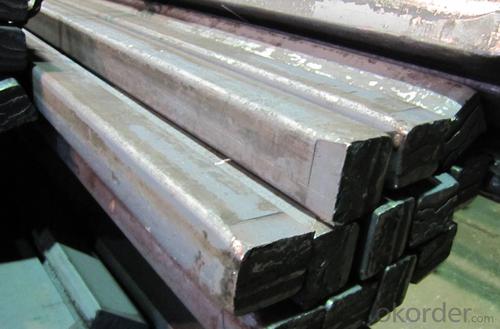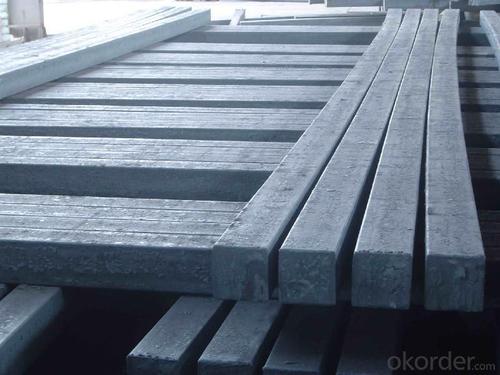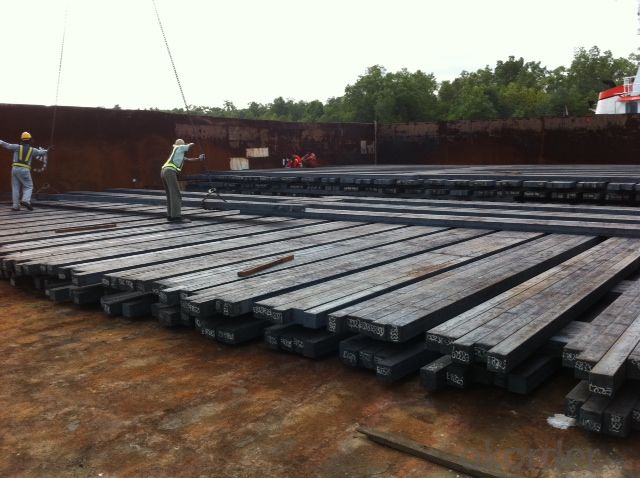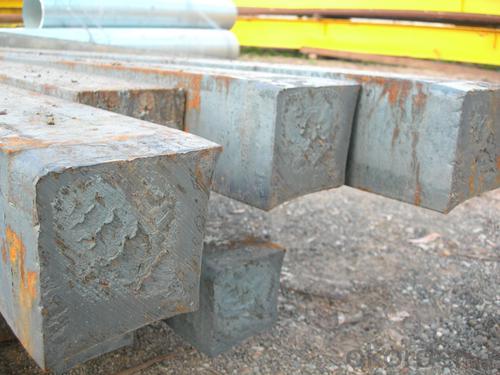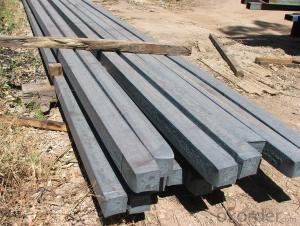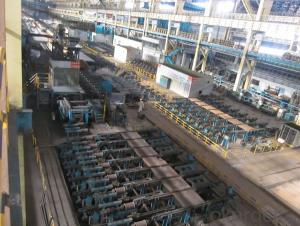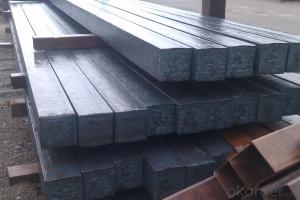Prime Q275 165mm Square Alloy Steel Billet
- Loading Port:
- Shanghai
- Payment Terms:
- TT OR LC
- Min Order Qty:
- 100 m.t.
- Supply Capability:
- 10000 m.t./month
OKorder Service Pledge
OKorder Financial Service
You Might Also Like
Structure of Prime Q275 165mm Square Alloy Steel Billet
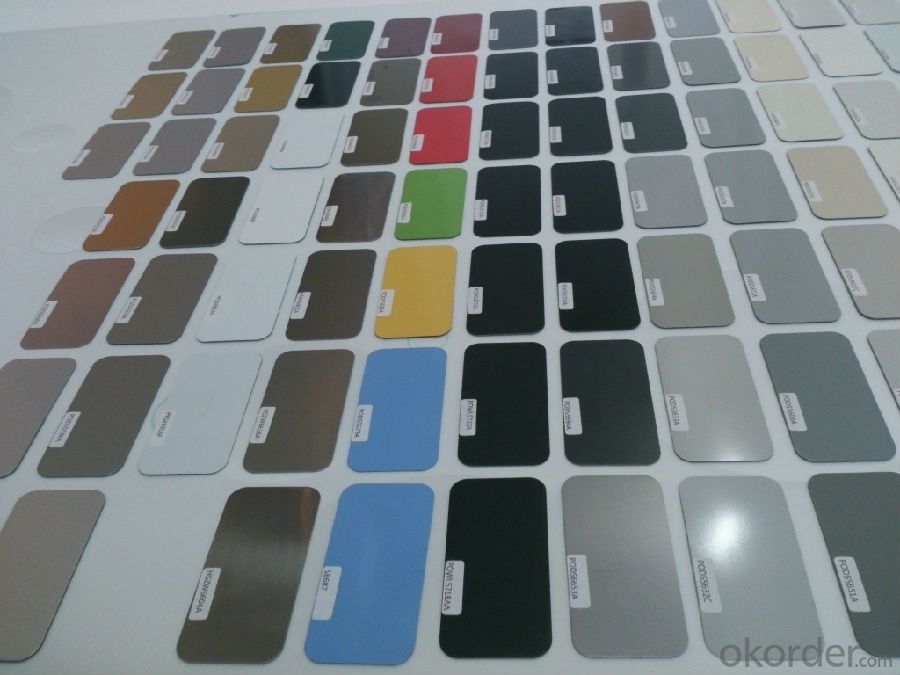
Description of Prime Q275 165mm Square Alloy Steel Billet
1. Prepainted steel coil is coated with organic layer, which provides higher anti-corrosion property and a longer lifespan than that of galvanized or galvalume steel sheets.
2. The base metals for prepainted steel coil consist of cold rolled, HDGI Steel, electro-galvanized and hot-dip alu-zinc coated steel. The finish coats of prepainted steel coil can be classified into groups as follows: polyester, silicon modified polyesters, polyvinylidene fluoride, high-durability polyester, etc.
3. The production process has evolved from one-coating-and-one-baking to double-coating-and-double-baking, and even three-coating-and-three-baking.
4. The color of the prepainted steel coil has a very wide selection, like orange, cream-colored, dark sky blue, sea blue, bright red, brick red, ivory white, porcelain blue, etc.
5. The prepainted steel coils can also be classified into groups by their surface textures, namely regular prepainted sheets, embossed sheets and printed sheets.

Main Feature of Prime Q275 165mm Square Alloy Steel Billet
They were one of several reasons for the wind to be taken out of the sails of the recent oil price momentum. Kuwait’s oil minister said that his country would only commit to a production freeze if all major producers are involved, including Iran. We also had Goldman telling us that oil markets will not rebalance at $40/bbl as it throws a lifeline to cash-strapped US producers.
If it is talk of a production freeze that is behind the rally it shows how low expectations have fallen. It is in the nature of oil people to talk the market up. Any bullish crumb is given exaggerated significance and any port in a storm will do. It is all but fact that the oil market will be tighter in the second half of this year when seasonal demand shoots up and US production continues to decline. It was the same picture last year. If OPEC and key non-OPEC production is frozen that will ensure the daily surplus will fall, but in all likelihood there will still be a surplus and there is an enormous global stockbuild to burn off.
Applications of Prime Q275 165mm Square Alloy Steel Billet
A. Corrugated design makes it excellent waterproof performance
B. Materials as prepainted steel sheets, galvanized steel sheets, galvalume (Al-Zn coated sheets) are available to make corrugated sheet.
C.Those material are durable, anti-corrosion in bad weather for 20-30 years based on it's Zinc(Galvanized) coating or AZ (Galvalume) coating.
D. Different shape of the sheet make it suitable for any style of buildings.
E.Easy to install, no need special tools to fix the sheet.
F.Light weight due to high strength to weight ratio of steel. Light weight means easier handling lower shipping costs, easier installation
G. Different color is availbe base on the RAL Standard make your building more beautiful.
H. We will provide the best solutions if you don't have a exact idea of the specification you want for the steel sheet based on your weather conditions, engineering structure, construction budget and so on.

Specifications of Prime Q275 165mm Square Alloy Steel Billet
Product | Billet |
Material Grade | SGCC / SGCH / DX51D+AZ, etc |
Thickness | 0.6-3.0mm |
Width | 500-1500mm |
Tolerance | Thickness: +/-0.02mm , Width:+/-2mm |
Zinc-coating | Z30-150g/m2 |
Technique | Raw material: Hot rolled steel coil --> Cold rolled_>hot dipped galvalume |
Surface | Dried, Chromated, Unoiled |
Spangle | Regular spangle , small spangle, zero spangle |
ID | 508MM 610MM |
Coil weight | 1-25MT |
Export package | Cardboard inner sleeves, Waterproof paper, galvanized steel covered and steel strip packed |
FAQ of Prime Q275 165mm Square Alloy Steel Billet
We have organized several common questions for our clients,may help you sincerely:
1. How Can I Visit There?
Our company is located in Tianjin City, China, near Beijing. You can fly to Tianjin Airport Directly. All our clients, from home or aboard, are warmly welcome to visit us!
2. How Can I Get Some Sample?
Poor trade figures from China punctured commodity optimism yesterday although they came with warnings that perhaps the numbers were distorted by Chinese New Year celebrations and we will have to wait for the March figures to gain a true picture of the state of China’s landing. Exports for February were -25.4% and imports -13.8% year-on-year.
- Q: How are steel billets measured?
- To ensure accurate dimensions and specifications, various techniques and tools are employed in measuring steel billets. One commonly utilized approach involves the utilization of calipers or micrometers. These tools enable precise measurements of the billet's diameter, length, and other necessary dimensions. Apart from physical measurements, non-destructive testing methods like ultrasonic testing or eddy current testing are also applied to steel billets. These techniques effectively identify any internal defects or inconsistencies within the billet, thus guaranteeing its quality and integrity. Moreover, the mass of steel billets is often determined through weighing. Depending on the size and weight of the billet, different weighing scales or load cells are employed for this purpose. The weight measurement plays a vital role in determining the billet's mass per unit length, which is crucial for calculating its density and other mechanical properties. In summary, the measurement of steel billets is an essential stage in the manufacturing process. It ensures that the billets meet the necessary specifications for further processing and utilization in diverse industries such as construction, automotive, and manufacturing.
- Q: What types of steel are commonly used for billets?
- The types of steel commonly used for billets include carbon steel, alloy steel, and stainless steel.
- Q: How do steel billet prices fluctuate in the market?
- Steel billet prices fluctuate in the market due to a variety of factors. One of the key factors is the demand and supply dynamics of the steel industry. When there is high demand for steel billets, prices tend to rise as suppliers have more leverage to set higher prices. Conversely, when demand is low, prices may decrease as suppliers compete for a smaller pool of buyers. Another important factor influencing steel billet prices is the cost of raw materials. Steel is primarily made from iron ore, coal, and scrap metal, and any fluctuations in the prices of these raw materials can directly impact the cost of producing steel billets. For example, if there is a shortage of iron ore, the price of steel billets may increase due to higher production costs. Additionally, market conditions and economic factors can also affect steel billet prices. Factors such as inflation, interest rates, and currency exchange rates can impact the overall cost of production and transportation, which in turn may influence the prices of steel billets. Furthermore, geopolitical events and trade policies can also play a role in price fluctuations. Tariffs, trade disputes, or changes in import/export regulations can disrupt the supply chain and impact the prices of steel billets. Overall, steel billet prices are subject to a complex interplay of factors, including demand and supply dynamics, raw material costs, market conditions, and geopolitical events. Traders, manufacturers, and investors closely monitor these factors to anticipate and respond to price fluctuations in the steel billet market.
- Q: What are the main factors affecting the quality of steel billets?
- There are several main factors that can significantly affect the quality of steel billets. These factors include the composition of the steel, the temperature and time of the heating process, the cooling rate, and the presence of impurities. Firstly, the composition of the steel plays a crucial role in determining its quality. The presence of certain elements such as carbon, manganese, and silicon can affect the mechanical properties of the steel, including its strength and hardness. The proper control and balance of these alloying elements are essential to ensure the desired quality of the steel billets. Secondly, the temperature and time of the heating process during the production of steel billets are critical factors. The heating process must be carefully controlled to achieve the optimal temperature for the desired transformation of the microstructure. Overheating or underheating can lead to the formation of undesirable phases or an inconsistent microstructure, which can negatively impact the quality of the billets. The cooling rate is another important factor affecting the quality of steel billets. The cooling process needs to be controlled to achieve the desired microstructure and mechanical properties. Too rapid cooling can result in the formation of brittle phases or residual stresses, while slow cooling can lead to coarse-grained structures with reduced strength. Furthermore, the presence of impurities in the steel can significantly affect its quality. Impurities such as sulfur, phosphorus, and non-metallic inclusions can decrease the mechanical properties and promote the formation of defects in the steel billets. Therefore, strict control of the raw materials and the implementation of effective refining techniques are necessary to minimize the presence of impurities. In conclusion, the main factors affecting the quality of steel billets are the composition of the steel, the temperature and time of the heating process, the cooling rate, and the presence of impurities. By carefully controlling and optimizing these factors, steel manufacturers can produce high-quality billets that meet the desired specifications and performance requirements.
- Q: What are the different surface treatments for improved surface cleanliness in steel billets?
- There are several surface treatments available for improving surface cleanliness in steel billets. These treatments are designed to remove impurities, oxides, and contaminants from the surface of the billets, resulting in a cleaner and more uniform surface. One common surface treatment is pickling, which involves immersing the steel billets in an acid solution. The acid helps dissolve and remove any oxides or scale present on the surface of the billets. This process not only cleans the surface but also helps improve the adhesion of subsequent coatings or treatments. Another surface treatment option is shot blasting or abrasive blasting. This process involves propelling abrasive materials, such as steel shot or grit, at high speeds onto the surface of the billets. The impact of the abrasive particles removes any contaminants, rust, or scale, resulting in a cleaner surface. Shot blasting is an effective method for preparing the surface of steel billets for further processing or coating. Chemical cleaning is another surface treatment technique used to improve cleanliness in steel billets. This process involves using chemical agents to dissolve and remove contaminants from the surface. Different chemicals, such as alkaline or acid-based solutions, can be employed depending on the type and severity of the contaminants present. Chemical cleaning can be an effective method for removing stubborn contaminants or residues from the surface of the billets. Additionally, mechanical cleaning methods, such as wire brushing or grinding, can be used to improve surface cleanliness. These techniques involve physically removing contaminants or scale from the surface using mechanical means. Wire brushing uses wire bristles to scrub the surface, while grinding involves the use of abrasive materials to remove any imperfections or contaminants. Overall, the choice of surface treatment for improved cleanliness in steel billets depends on several factors, including the specific contaminants present, the desired level of cleanliness, and the intended application of the billets. It is essential to consider the effectiveness, cost, and environmental impact of each treatment method to select the most suitable option.
- Q: What is the role of steel billets in the manufacturing of construction machinery?
- Steel billets play a crucial role in the manufacturing of construction machinery due to their exceptional strength and durability. These billets, which are semi-finished products made from molten steel, are shaped into various forms such as bars, rods, or sheets, depending on the specific machinery being produced. One of the primary reasons steel billets are used in the construction machinery industry is their ability to withstand heavy loads and extreme conditions. Construction machinery, such as excavators, bulldozers, cranes, and loaders, are subjected to intense stress and pressure during operation. Steel billets, being made from high-quality steel, provide the necessary structural integrity and resistance to deformation, ensuring the machinery can handle demanding tasks without compromising safety or performance. Additionally, steel billets offer excellent weldability, which is crucial in the construction machinery manufacturing process. Welding is often required to join different components together, and the use of steel billets ensures strong and reliable welds, contributing to the overall stability and longevity of the machinery. Moreover, steel billets can be easily machined and formed into complex shapes, allowing for the production of intricate parts and components required for construction machinery. This versatility enables manufacturers to design and fabricate machinery with precise specifications, enhancing their functionality and efficiency on the job site. Furthermore, steel billets are known for their resistance to corrosion and rust, making them ideal for construction machinery that is frequently exposed to harsh environmental conditions, including moisture, chemicals, and abrasive materials. This resistance ensures the longevity of the machinery, reducing maintenance costs and downtime. In summary, steel billets are indispensable in the manufacturing of construction machinery due to their strength, weldability, machinability, and resistance to corrosion. By incorporating steel billets into the production process, manufacturers can create robust and reliable machinery that can withstand heavy loads, extreme conditions, and perform efficiently in the construction industry.
- Q: What are the different surface treatments applied to stainless steel billets?
- There are several different surface treatments that can be applied to stainless steel billets to enhance their appearance and improve their corrosion resistance. Some of the most common surface treatments include: 1. Pickling: This process involves immersing the stainless steel billets in a bath of acid, such as nitric or hydrofluoric acid, to remove any scale or oxide layers that may have formed during the manufacturing process. Pickling helps to restore the stainless steel's original finish and provides a clean, smooth surface. 2. Passivation: Passivation is a chemical process that is used to enhance the corrosion resistance of stainless steel. It involves immersing the billets in an oxidizing solution, typically a nitric acid bath, to remove any embedded iron or other contaminants from the surface. Passivation forms a thin oxide layer on the surface of the stainless steel, which helps to prevent corrosion and maintain the material's integrity. 3. Electropolishing: This is an electrochemical process that is used to remove a thin layer of material from the surface of the stainless steel billets. By passing an electric current through the billets while they are immersed in an electrolyte solution, the surface is smoothed and any surface defects or impurities are removed. Electropolishing not only improves the appearance of the stainless steel, but also enhances its corrosion resistance and makes it easier to clean. 4. Grinding and polishing: These mechanical processes involve using abrasive materials to remove any imperfections or surface irregularities from the stainless steel billets. Grinding is typically done using a coarse abrasive wheel, while polishing uses progressively finer abrasives to achieve a smooth, reflective surface. Grinding and polishing can be used to achieve a variety of finishes, ranging from a brushed or satin finish to a mirror-like polished finish. These different surface treatments can be used individually or in combination to achieve the desired appearance and performance characteristics for stainless steel billets in various applications.
- Q: What are the different types of steel billet quality control tests?
- To ensure the integrity and suitability of steel billets for further processing, various types of quality control tests are conducted. These tests play a vital role in maintaining the desired quality standards in the steel industry and detecting any defects or inconsistencies in the billets. Some commonly used tests for steel billet quality control are as follows: 1. Visual Inspection: This test involves visually examining the billets to identify surface defects like cracks, seams, or dents. It is a fundamental form of quality control and can be carried out quickly. 2. Dimensional Inspection: In this test, the dimensions of the billets are measured and compared to specified tolerances. This ensures that the billets fall within the required size range and meet the dimensional requirements for further processing. 3. Chemical Composition Analysis: This test involves analyzing the chemical composition of the steel billets to ensure they meet the specified requirements. It includes determining the percentages of different elements such as carbon, manganese, sulfur, and phosphorus. 4. Mechanical Testing: This test evaluates the mechanical properties of the steel billets, such as tensile strength, yield strength, and elongation. These properties are crucial in determining the billets' suitability for specific applications. 5. Ultrasonic Testing: This non-destructive testing method utilizes ultrasonic waves to detect internal defects like cracks or voids in the billets. It is particularly effective in identifying hidden defects that may not be visible during visual inspection. 6. Magnetic Particle Inspection: This test involves applying a magnetic field to the billets and then introducing magnetic particles to the surface. Any surface or near-surface defects will cause the particles to gather, indicating the presence of a defect. 7. Eddy Current Testing: This method uses electromagnetic induction to detect surface defects or variations in the billets' electrical conductivity. It is useful in identifying cracks, voids, or inconsistencies in the billets' microstructure. 8. Microstructure Analysis: This test involves examining the microstructure of the steel billets under a microscope to assess homogeneity, grain size, and the presence of any undesirable phases. It aids in determining the overall quality and suitability of the billets for further processing. These tests, alongside other specific tests, are an integral part of steel billet quality control. By conducting these tests, manufacturers can ensure that the billets meet the required standards and possess the necessary properties for their intended applications.
- Q: What are the common quality control measures for steel billets?
- Some common quality control measures for steel billets include visual inspection for surface defects, dimensional checks to ensure the correct size and shape, hardness testing to verify the desired hardness level, chemical analysis to determine the composition of the steel, and non-destructive testing techniques such as ultrasonic or magnetic particle inspection to detect internal flaws or cracks. Additionally, mechanical property testing, such as tensile or impact testing, may be performed to evaluate the strength and toughness of the billets.
- Q: What are the potential applications of steel billets in the telecommunications industry?
- Steel billets can be used in the telecommunications industry for various applications such as tower construction, antenna support systems, and cable management. The strength and durability of steel make it an ideal material for these purposes, ensuring the stability and longevity of telecommunications structures. Additionally, steel billets can be used for manufacturing equipment and components like brackets, frames, and enclosures, providing protection and support for sensitive telecommunications devices.
Send your message to us
Prime Q275 165mm Square Alloy Steel Billet
- Loading Port:
- Shanghai
- Payment Terms:
- TT OR LC
- Min Order Qty:
- 100 m.t.
- Supply Capability:
- 10000 m.t./month
OKorder Service Pledge
OKorder Financial Service
Similar products
Hot products
Hot Searches
Related keywords
